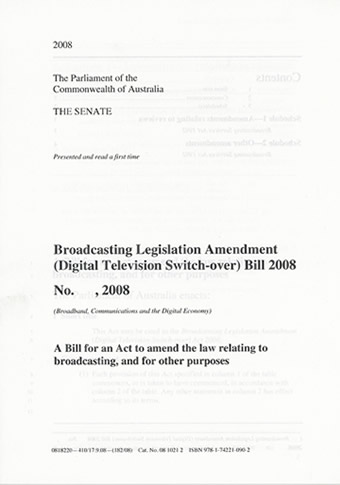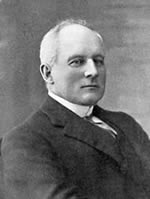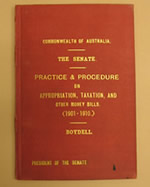112 First reading
- Except in respect of bills which the Senate may not amend, the question – That this bill be now read a first time – shall be put by the President immediately after the bill has been received, and shall be determined without amendment or debate.
- In respect of bills which the Senate may not amend, the question for the first reading may be debated, and in the debate matters relevant and not relevant to the subject matter of the bill may be discussed. A senator shall not speak for more than 15 minutes in that debate.
- On every order for the reading of a bill the title only shall be read.
- After the first reading, a future day shall be appointed for the second reading of the bill, and the bill shall be printed.
Amendment history
Adopted: 19 August 1903 as SOs 181, 182, 184 and 185 (corresponding to paragraphs (1) to (4), the latter two renumbered as SOs 183 and 184 for the first printed edition
Amended:
- 9 September 1909, J.120 (to take effect 1 October 1909) (addition of requirement for the bill to be printed after its first reading)
- 1 September 1937, J.44 (to take effect 1 October 1937) (scope of debate on the first reading of a non-amendable bill clarified)
- 13 February 1997, J.1447 (to take effect 24 February 1997) (time limit on first reading speeches on a non-amendable bill relocated from SO 189)
1989 revision: Old SOs 189 to 192 combined into one, structured as four paragraphs and renumbered as SO 112; some streamlining and modernisation of language
Commentary

A bill as read a fist time
While rules providing for the different stages of legislative consideration are standard inclusions in the standing orders of any legislature, the novel element in these rules was the provision for bills which, by virtue of s. 53 of the Constitution, the Senate was unable to amend. Marginal notes in the Standing Orders Committee’s proposed orders indicate that the machinery was based on precedents from Victoria, NSW and South Australia, but the provision for debate on the first reading of non-amendable bills was entirely new.[1]
The rationale for providing a debating opportunity which was not available in other houses at this point was to compensate senators for lack of access to a grievance debate.[2] According to Senator Pearce’s later recollection of President Baker’s explanation of the procedure, it had not been intended that the bill itself be discussed at this stage but that senators have an opportunity to ventilate grievances, and that debate therefore be confined to matters not relevant to the bill. By the time that Senator Pearce spoke in 1937, this rationale had been modified by rulings of subsequent Presidents[3] and the Standing Orders Committee had recommended that the original wording of the standing order (“debate need not be relevant to the subject matter of such bill”) be replaced with the current formulation in paragraph (2) clarifying that matters both relevant and not relevant to the bill could be discussed.[4] One reason given was that as the standing orders allowed requests to be made at the first reading stage, and requests would be for amendments relevant to the bill, therefore it was necessary to provide for relevant debate.[5] Changes to this effect were adopted on 1 September 1937.[6]
A slightly different perspective is given on the issue of debate on the first reading of a bill by C. B. Boydell, Clerk of the Senate (1908–16), in his 1911 booklet on money bills.[7] On the basis that the Senate was elected on a popular franchise similar to the lower House and was therefore quite different to upper houses in the states, “it was claimed that Senators should have an opportunity of discussing the finances of the Commonwealth, similar to that permitted in the Budget debate in the House of Representatives”. Boydell refers to debate on the Consolidated Revenue (Supply) Bill 1901 (also known as Supply Bill (No. 1) 1901) on 13 June 1901 when senators complained that because the estimates were not attached to the bill, there appeared to be no opportunity for senators to be “allowed the privilege of discussing everything, from Dan to Beersheba”.[8] It was to provide such an opportunity that the standing orders were framed to permit debate on the first reading of a non-amendable bill “and that the debate need not be relevant to the subject-matter of the Bill. Thus the opportunity is afforded for a general debate on the financial and other proposals of the Government”.[9]

Charles Boydell, Clerk of the Senate 1908-17, author of the first reference work of the Senate's powers under section 53 of the Constitution (Source: Commonwealth Parliamentary Handbook)
The original debate on the adoption of these standing orders went awry over the issue of proposed SO 183 which required a printed copy of a bill to exist before its first reading. Misguided complaints from Senator Symon that private senators would be put to unnecessary expense by this rule had led to its defeat in June 1903.[10] When proposed SO 184 (current paragraph (3)) was reconsidered in August, Senator Pearce (ALP, WA) attempted to amend it by adding a requirement for the bill to be printed after it had been read. President Baker pointed out that the committee had previously struck out as unnecessary the requirement for the bill to be printed; that Pearce’s amendment would provide for printing after first reading whereas it ought to be before first reading; and, thirdly, that it was universal practice in parliaments for any member’s bill to be printed as a matter of course. On these bases, Senator Pearce withdrew his amendment leaving the standing orders without a requirement for bills to be printed after introduction. This situation was clarified when the Standing Orders Committee conducted its first major tidying-up exercise in the wake of the change to the Constitution in 1906 affecting the timing of senators’ terms. The printing requirement was added to paragraph (4); in other words, after the first reading. This reflected current practice for a motion to be moved after the first reading, that the second reading of the bill stand an order of the day for a certain future day, and that the bill be printed. As President Gould explained when moving the amendment, it was necessary for the Senate to direct the printing of the bill in order to be able to deal with it at the second reading stage.[11]

Boydell's small booklet on the powers of the Senate, the first of many scholarly writings by Senate clerks
Until 1993, it was common practice for government bills to be printed both for presentation and “as read a first time”. The introductory version was abandoned as a cost-saving measure and all bills are now printed and circulated on introduction “as read a first time”, even though this is technically anticipatory. Senate procedures include a vote on the question for the first reading which may be negatived. Although it is rare for bills to be negatived at first reading, there may be occasions when this occurs and the annotation is therefore rendered incorrect.[12]
In 1996, the Procedure Committee recommended a consolidation and tidying up of the standing orders which included the relocation of the time limit of 15 minutes for first reading speeches from SO 189 to its present location in paragraph (2). The consolidation was adopted on 13 February 1997.[13]
Subject to SO 113, the Clerk reads the long title of the bill when the first reading has been agreed to.